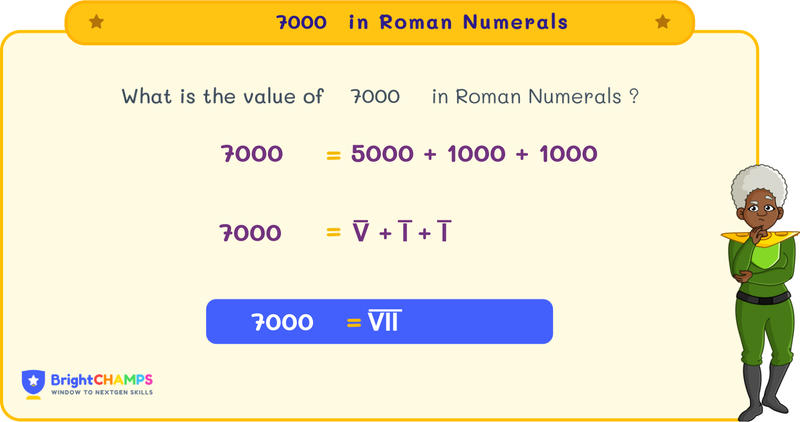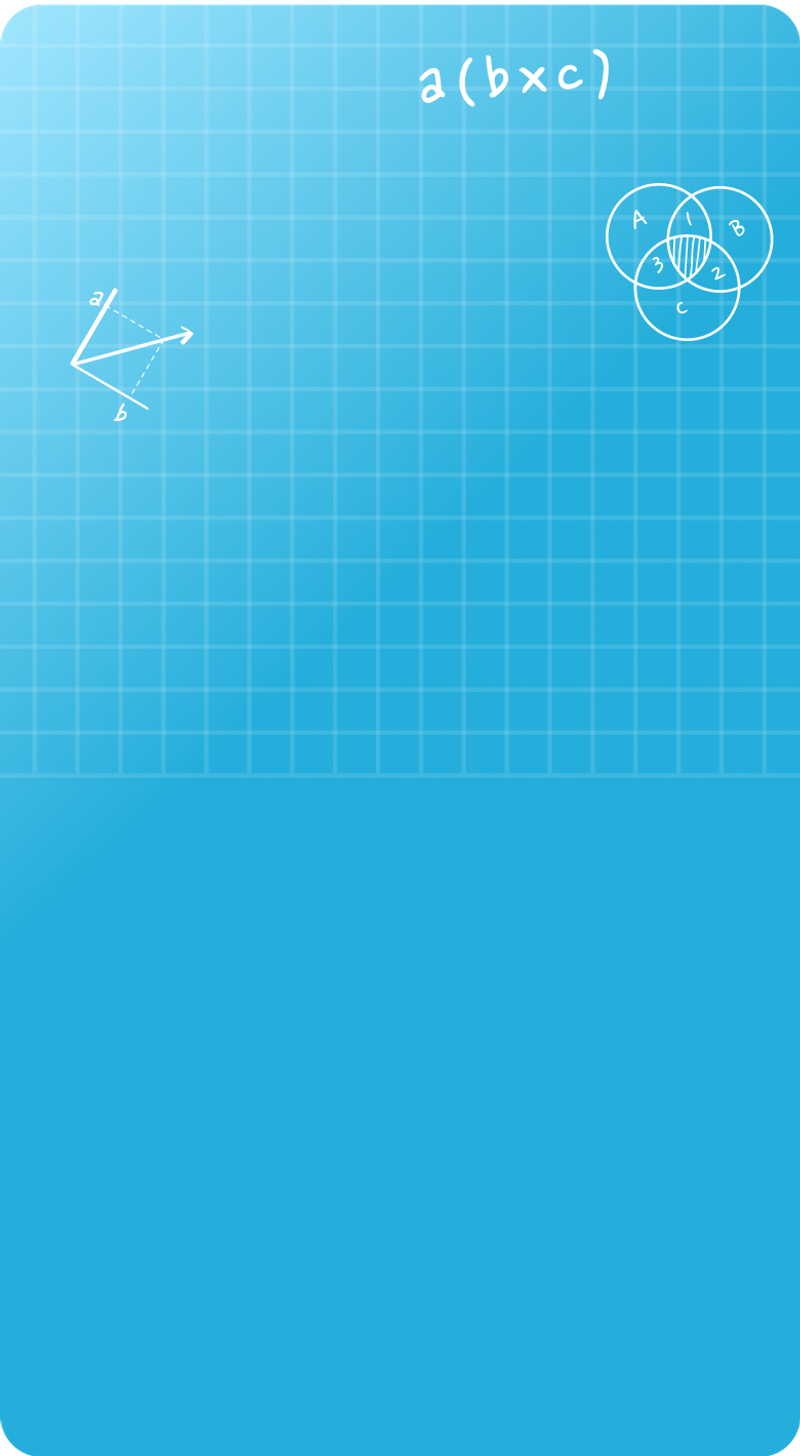Summarize this article:
 263 Learners
263 LearnersLast updated on 5 August 2025
7000 in Roman Numerals

Roman numerals are a way of expressing numbers using symbols. I, V, X, L, C, D, and M are the symbols we use. Roman numerals are used in royal titles, book names, sequences, and so on. Here we will be discussing Roman numerals, rules, and examples.

What is 7000 in Roman Numerals?
The royal titles, such as Louis IX, Louis X, and so on. Have you noticed the names and wondered what these symbols (IX and X) represented?
Those are the Roman numerals. Earlier, people used to count using fingers, sticks, bones, etc. As life became more complex, a standard form was required to count. Ancient Romans used the Roman numeral system to count. I (1), V (5), X (10), L (50), C (100), D (500), and M (1000) are the symbols we use to count.
In Roman numerals, we use _V̅I̅I̅_ to represent 7000, where V̅ represents 5000 and I̅I̅ represents 2000. Let’s learn more about Roman numerals and how we write them.


Basic Rules for 7000 in Roman Numerals
There are certain basic rules for writing a number in Roman numerals. In this section, let’s discuss some basic rules that need to be remembered when writing a number in Roman numerals.
Rule 1: Addition Method
The addition method is used when a smaller number is placed after a larger number. For example, VI → V + I → 5 + 1 = 6.
Rule 2: Repetition Method
To write a large number, certain Roman numerals can be repeated up to three times. For example, III → 3.
Rule 3: Subtraction Method
If a small number is followed by a large number in Roman numerals, we subtract the smaller number from the larger number. For example, IX → X - I → 10 - 1 = 9.
Rule 4: Limitation Rule
The symbols cannot be repeated more than three times, and some symbols like V, L, and D cannot be repeated. For example, we won't write VV for 10; instead, we use X, and for 8, we write VIII, not IIIIIIII.

How to Write 7000 in Roman Numerals
Let’s now learn how to write 7000 in Roman numerals. Follow these methods to write the number in Roman numerals.
- By Expansion Method
- By Grouping Method

7000 in Roman Numeral by Expansion Method
In the expansion method, based on the place value, the number is broken down. In this section, we will learn how to write 7000 in Roman numerals using the expansion method.
To write 7000 in Roman numerals, follow these steps:
Step 1: Break the number down based on place value, such as ones, tens, hundreds, etc.
For 7000, we write it as 5000 + 2000.
Step 2: Convert the number into Roman numerals.
5000 in Roman numerals — V̅
2000 in Roman numerals — I̅I̅
Step 3: Combine the Roman numerals together. Therefore, 7000 in Roman numerals is V̅ (5000) + I̅I̅ (2000) = _V̅I̅I̅_

7000 in Roman Numeral by Grouping Method
When writing a large number into Roman numerals, we group the number.
To write 7000 in Roman numerals, we group 7000 as 5000 + 2000.
5000 in Roman numerals — V̅
2000 in Roman numerals — I̅I̅
So, 7000 is written as _V̅I̅I̅_ in Roman numerals.

Common Mistakes and How to Avoid Them in 7000 Roman Numerals
Students make mistakes when writing a number in Roman numerals. To master Roman numerals, we can learn a few common mistakes and ways to avoid them.

7000 in Roman Numerals Examples

Problem 1
A museum received a donation of MCMXLV artifacts and later acquired an additional MMMLV. What is the total number of artifacts in Roman numerals?

The total number of artifacts is MMMMMMMCM.
Explanation
First, we convert the numbers to Roman numerals and then sum them up.
MCMXLV = 1945
MMMLV = 3055
1945 + 3055 = 5000
5000 in Roman numerals is MMMMM.
Therefore, the total number of artifacts is MMMMMMMCM.

Problem 2
Calculate the difference when the Roman numeral representing 7000 is subtracted from the numeral representing 10000.

The difference is MMM.
Explanation
First, convert the numbers to Roman numerals.
10000 = X (represented here as a placeholder for understanding, but often notated as (X) in historical contexts)
7000 = MMMMMMM
The difference is 10000 - 7000 = 3000.
3000 in Roman numerals is MMM.

Problem 3
An ancient scroll mentions two important years: 4500 and 2500. What is the sum of these years in Roman numerals?

The sum of the years is MMMMMMM.
Explanation
First, convert the numbers to Roman numerals.
4500 = MMMM D
2500 = MMD
4500 + 2500 = 7000
7000 in Roman numerals is MMMMMMM.

Problem 4
A historian found a document that lists events in the years MMMMM and MM. What is the combined total of these years in Roman numerals?

The combined total of these years is MMMMMMM.
Explanation
Convert the years into Roman numerals:
MMMMM = 5000
MM = 2000
Add the numbers together: 5000 + 2000 = 7000
7000 in Roman numerals is MMMMMMM.

Problem 5
Write the Roman numeral for the sum of 3500 and 3500 using the expansion method.

The Roman numeral for the sum is MMMMMMM.
Explanation
First, convert the numbers to Roman numerals.
3500 = MMMD
3500 = MMMD
Add the numbers together: 3500 + 3500 = 7000
Using expansion, 7000 is MMMMMMM in Roman numerals.


FAQs on 7000 in Roman Numerals
1.What is 9000 in Roman numerals?
2.How to write 7000 in Roman numerals?
3.What is 8000 in Roman Numerals?
4.Is _V̅I̅I̅_ a prime number?
5.What are the multiples of 7000?
6.How can families in India create number-rich environments to improve 7000 in Roman Numerals skills?
7.What role do numbers and 7000 in Roman Numerals play in helping children in India develop problem-solving skills?
8.How can children in India use numbers in everyday life to understand 7000 in Roman Numerals?
9.What are some fun ways kids in India can practice 7000 in Roman Numerals with numbers?

Important Glossaries for 7000 in Roman Numerals
- Addition Rule: The addition method is used when a large number is followed by a smaller numeral; here, the values are added. For example, VI = V + I = 5 + 1 = 6.
- Grouping Method: Here, the given numbers are grouped based on their place value and then converted into Roman numerals. For example, 7000 = 5000 + 2000 = _V̅I̅I̅_.
- Repetition Rule: Certain symbols (I, X, C, M) in the Roman numeric system can be repeated only up to three times. For example, III = 3 (I is repeated three times to represent the number 3).
- Subtraction Rule: This rule is used when a smaller numeral precedes a larger numeral, indicating subtraction. For example, IV = V - I = 5 - 1 = 4.
- Multiplication Rule: Roman numerals are multiplied by 1000 by placing a line above the numeral. For example, V̅ = 5000.

Explore More numbers
![Important Math Links Icon]() Previous to 7000 in Roman Numerals
Previous to 7000 in Roman Numerals
![Important Math Links Icon]() Next to 7000 in Roman Numerals
Next to 7000 in Roman Numerals


Hiralee Lalitkumar Makwana
About the Author
Hiralee Lalitkumar Makwana has almost two years of teaching experience. She is a number ninja as she loves numbers. Her interest in numbers can be seen in the way she cracks math puzzles and hidden patterns.
Fun Fact
: She loves to read number jokes and games.




